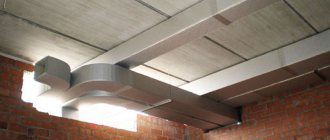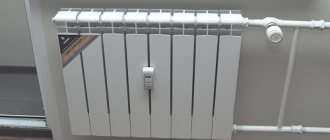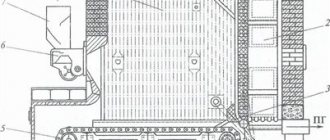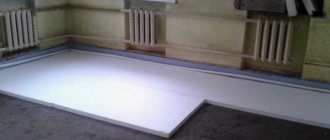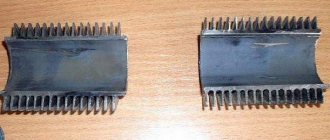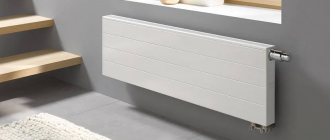Add to bookmarks
One of the skills required for high-quality and quick replacement of pipes at home is accurately determining their diameter using available tools.
Before making measurements, you should understand in what units they are made. It is generally accepted that the diameter of pipes is always measured in inches (1 inch = 2.54 cm).
Whether it's problems with the plumbing or plumbing in the bathroom or problems with the water supply in the kitchen, knowing how to determine the diameter of a pipe using available tools will come in handy.
Of course, there are special tools for measuring, such as a ruler-circometer, laser meter, etc. But everything can be much simpler.
Before making measurements, you should understand in what units they are made. It is generally accepted that such values are always measured in inches (1 inch = 2.54 cm), and the standard size, for example, of steel products is most often 1 or 0.5 inches. By the way, the diameters of plastic, steel and metal-plastic parts vary.
The next step is to select the measured value. External - more important, because It is on it that threads and threaded connections are installed. This diameter directly depends on the thickness of the pipe walls. The dimensions of the wall thickness are determined by the difference between the external and internal diameters of a given pipe.
Why do you need to calculate pipes?
In most cases, there is a need to calculate the sizes and proportions of pipes in advance. This may be necessary for good communication with other systems.
It is important for builders to focus on this:
- How passable;
- Heat loss;
- How much insulation;
- How many anti-corrosion materials;
- How rough are the pipes?
Calculation of pipe sizes
In order to calculate everything accurately and accurately, it is important to first measure these indicators:
- What are the pipes made of?
- What section;
- What are the diameters?
- How thick are the walls;
- How long.
Some of this data is written on the pipe certification document, in reference materials or GOST.
Metric and inch units
Before measuring the size of the assortment, you should take into account that the technological features of laying and carrying out calculations when working with steel and plastic lines are different.
For this reason, it is necessary to first gain an understanding of the standard sizes of pipe-rolling materials for pipelines, and only then measure them. Without this knowledge, it is impossible to determine the size of the assortment in millimeters or inches.
Rolled steel pipes are primarily determined by their internal volume, measured in inches. In accordance with these units, you can find the names “inch” and “half-inch” pipe materials. One inch is equal to 25.4 mm, and half of it is correspondingly defined as 12.7 mm.
Plumbing fixtures are in no hurry to measure the outer diameter. Often installation can be done without it. It is necessary to measure this value in cases where it is necessary to measure a pipeline fastened with joints on a threaded connection.
It is usually cut on the outer part of the tubular product, and its size depends on the dimensions of the wall of the tubular product. During these actions, you should remember that if you measure pipes with different internal volume indicators, the wall size will be different.
To make it easier to measure and calculate the amount of materials needed for a pipeline, you can use a special thread system to indicate the external volume of pipe products. These values differ from the usual indicator, which can be measured in mm.
To correctly determine the size of pipe products in millimeters or find out their dimensions in inches, you need to take into account the following information.
For example, if the diameter of the metric thread knurling is designated M16, then the tubular product has an outer volume of 16 mm. In the version with pipe threads, all this is different. In inches these calculations are slightly different.
The outside diameter of a half-inch product does not reach 21 millimeters, and its thread knurling is the same in size. And this product gets its name “half-inch” because of the volume inside. In inches this value is denoted as ½. To make it easier to convert inches to mm, it is recommended to use special tables.
Calculation of diameter with volume
The calculation formulas are simple and are studied at school. In order to find out the diameter of the pipe, you first need to calculate the circumference. A centimeter ruler will come to the rescue.
If it is not there, you can wrap the pipe with regular thread and then use a ruler to measure the length.
Circumference formula:
- L=n*D,
- L is the sign of the circumference;
- n is the sign of the constant number PI (3.1415);
- D is the sign for the diameter of the circle.
By changing the formula a little, you can calculate the diameter of the pipeline:
- D=L/p
After measuring the thickness of the pipes, you can easily find out the internal diameter. You just need to subtract the thickness multiplied by two from the diameter of the outer side.
Taking words to action
In order to correctly measure both diameters, you should take into account the features of all measurement methods, because each of them is suitable for different conditions.
In order to correctly measure both diameters, you should take into account the features of all measurement methods, because each of them is suitable for different conditions.
One method is to measure the circumference of the piece by wrapping it with a measuring tape or tape measure. Then the resulting value must be divided by Pi (3.14).
We will need:
- ruler;
- calipers;
- tape measure (measurement tape).
If access to an area of the part is not difficult and you can measure it before installation, then the easiest way is to use a ruler or tape measure. The outer diameter is determined by placing a ruler over the widest part of the pipe and counting from the first outer point on the scale to the last.
There may be cases where measurements are already indicated in inches (imported deliveries). To convert to centimeters, the size is multiplied by 2.54, and to convert back to inches - by 0.398.
There is another way to determine the internal diameter if the pipe is directly accessible. The walls are measured along the cut using a caliper or ruler, and then the resulting reading is subtracted from the measurements of the outer diameter and multiplied by 2.
What if there is no direct access to the required area? One method is to measure the circumference of the piece by wrapping it with a measuring tape or tape measure. Then the resulting value must be divided by Pi (3.14). This way we can find out the outer diameter of the pipe. This method is also suitable if the length of the caliper or ruler is not enough.
There is a method for determining the outer diameter that excludes all sorts of calculations, but only for those parts for which it is no more than 15 cm. To do this, you will need to measure the readings using only a caliper, on the scale of which the correct results are measured.
One of the most extraordinary ways is to compare the values of a pipe with some object, take photographs and further recognize the measurements. Take a ruler or any object whose length is already known in advance (a coin) and bring it to the area to be measured, then take a picture. Further scaling on the computer will help determine the exact dimensions of the outer diameter. This method is ideal if it is impossible or extremely difficult to get close to the area being measured.
Imagine that you are going to paint the gas pipes connected to your house. How much paint will be needed? One or two cans? As a rule, on paint containers it is written what area this amount of paint is designed to cover. This means that in order to accurately determine how many cans of paint to take, you need to calculate the area of the gas pipes.
Imagine that you are going to paint the gas pipes connected to your house. How much paint will be needed? One or two cans? As a rule, on paint containers it is written what area this amount of paint is designed to cover.
You will need
- - roulette;
- - caliper;
- - strong thread;
- - calculator.
Instructions
To calculate the area of a round pipe, find out the length of this pipe in linear meters. Also for the calculation you will need the outer diameter of the pipe.
Calculate the outer diameter of the gas pipe. There are two ways to do this. The first method is to measure the outer diameter of the gas pipe using a caliper. To do this, spread the jaws of this measuring tool and attach it to the pipe so that the pipe is between the jaws of the caliper. Then move the jaws of the measuring tool: they should tightly grip the gas pipe. Looking at the measuring scale, determine the outer diameter of the pipe. The second way is to wrap a thick thread around the pipe. Then use a tape measure to measure the circumference of the pipe. Substituting the value into the formula D = L / Pi, where L is the circumference of the pipe, Pi = 3.14 (the number “pi”), calculate the outer diameter of the gas pipe. Convert the resulting indicator to
Water supply, heating, sewer, chimney, casing, copper, steel, plastic, metal-plastic, narrow, wide - pipes for various purposes from various materials surround us everywhere. The need to lay new communications or replace old ones arises both during the construction of a house and during ongoing repairs. When drawing up a project for the upcoming work, it would not hurt to arm yourself with a calculator to calculate the weight of the pipe, its mass, volume and other parameters.
Calculation of pipe cross-sections
Before finding out, you need to find out the area of the circle. But it is important to take into account the difference in outside diameter and wall thickness.
Formula for calculating area:
- S=n*R²,
- S - area sign;
- n — PI sign (3.1415);
- R is the radius sign.
If outside diameter and thickness values are used for calculations, it is worth using this formula:
- S=n*(D/2-T)²,
- S is the sign of the cross-sectional area;
- n — PI sign (3.1415);
- D - outside diameter sign;
- T is the sign of thickness.
If the diameter outside the pipe is 3 meters, the thickness is 15 millimeters. First of all, everything needs to be coordinated, that is, the millimeter must be converted into a meter. It turns out that the thickness is 0.015 meters.
Next you need to apply the formula for calculation:
- S=3.141*(3/2-0.015m)²=4.66m²
- It turns out that the cross-section of the pipes is 4.66 m2.
How accurate the calculations will be depends on the number pi. But during the construction process there is no need to calculate everything exactly. The number "pi" can be taken as 3.141. And the final number must be reduced to two digits after the decimal point.
Drafting
The design documentation of the heating circuit is carried out in compliance with general requirements. The entry and exit points from the gas boiler are considered the main ones. The initial section of the pipeline, even when using a polypropylene pipe, is made of metal (approximately 1.5 m from the exit point) until the first branch of the system.
Then the entire branch of plastic or polypropylene pipes is laid out. In this case, the sections depend on the length, but usually each subsequent branch is made smaller than the previous one. The schematic diagram for connecting the pipe system with the coolant is the same, only it is connected to the inlet of the heating boiler.
Calculation of internal volume
For this type of calculation, it is necessary to know the area of the circle based on the outer diameter.
This area is found using the following formula:
- S=n*R² or S=n*(D/2)²,
- S - area sign;
- n — PI sign (3.1415);
- D is the sign of the outer diameter.
The resulting number must be multiplied by the length of the segment. This way the volume is found, which is expressed in meters per cube.
The calculation formula looks like this:
- V=S*H:
- V - volume sign;
- S - area sign;
- H is the sign of the length of the segment.
If you have a pipe with an outer diameter of 55 centimeters and a length of 3 meters, you can easily measure the volume. First you need to convert all values to one unit of measurement, that is, meters. 55 centimeters turns into 0.55 meters.
Now all that remains is to substitute the available values into this formula and calculate using a calculator:
- S=n*(D/2)² = 3.141*(0.55/2)²=0.075m²
It remains to use the second formula:
- V=S*H = 0.075*3=0.226m³
Factors influencing choice
The choice of pipes is influenced by a number of factors, including the optimal temperature and water pressure. You need to choose the right coolant pressure and temperature when choosing autonomous heating. Which values will be used depends on the heat transfer rate of the batteries.
Cast iron radiators have the lowest heat transfer coefficient, while aluminum products have the highest. When the liquid temperature does not exceed +75°C (the most optimal indicator), the rated thermal power should be taken into account when calculating the required number of radiators and their sections. But with constantly changing air temperatures outside, it is necessary to adjust the heating of the coolant so that the room always has a comfortable temperature and there is no unnecessary energy consumption.
In addition to temperature, for normal operation it is necessary to control the pressure in the pipes and calculate their suitable diameter. A pressure of 1.5-2 atmospheres is the most optimal. When it increases to 3 units, the entire circuit may malfunction and leaks and ruptures may occur. Therefore, to periodically check the pressure in the circuit during installation, you need to leave a free gap for installing pressure gauges. By using expansion tanks, it is possible to reduce the pressure.
The heating system can be installed using one- or two-pipe schemes. To make the room comfortable, the most suitable option should be chosen when drawing up the project.
Single-pipe wiring will be cheaper, but if price does not affect the choice and you need high operating efficiency, then a two-pipe circuit will be suitable.
Calculation of pipe mass
Weight data will allow you to find out how much money will need to be invested in transporting pipes. Mass is found by multiplying the volume by the density of the substance from which it is made.
To carry out all the necessary calculations, you need to know about several important data about the pipe:
- What material is it made of?
- What are the external and internal diameters?
- How thick are the walls?
First, the mass of 1 linear meter is calculated. And to find out the total mass, the resulting number is multiplied by the total number of linear meters.
Having collected all the necessary data, you should use a special calculator.
We design a water heated floor
As mentioned above, one of the main indicators for designing a heating system is the density of the effective flow of thermal energy produced by 1 m2 of heat exchanger (g, W/m2) - the specific power of the heated floor. It must fully compensate for the heat loss of the room - Q, W.
g=Q/F,
where F, m2 – useful floor area that will be used for heating. It is taken as the total area of the room minus the places where the furniture will be installed, as well as a free zone of 20-30 cm from the walls and furniture.
The value of Q takes into account many parameters, partially given in the previous section. To accurately calculate it, you can use the methodology proposed in the reference manual by E. G. Malyavina “Heat loss of a building,” which requires an in-depth approach. However, in practice, it will be easier for a private owner to accept certain average values of heat loss from typical buildings. For example, a room of 18 m2 with one external wall and a window, as well as ceilings up to 3 m, will have an approximate heat loss of 1800 W. This indicator is valid for calculating heated floors in the premises of an apartment building built in a temperate climate zone. But for a private house it will have to be increased by 1.2-1.5 times. Heat loss values also increase if large windows are installed, the room is corner, thin walls, etc.
The specific heat transfer of a heated floor must be within certain limits. After all, its overheating leads to discomfort for residents and destruction of construction and finishing materials. Thus, the maximum surface temperature of the floor covering (tf, C) is recommended:
- + 29°С – for residential premises (bedroom, living room, office);
- + 33°С – for rooms with high humidity (bathrooms, kitchens);
- + 35°С – for areas near external walls.
Tabular selection of pipeline laying pitch
Knowing the density of the effective thermal energy flux (g, W/m2), the type of coating used (its heat transfer resistance - Rw, m2*OC/W or m2*K/W), the recommended floor surface temperature for a given room (tf, C), as well as the gradient of the operating temperatures of the coolant (tz/tp, C/C), you can select the pipe pitch (b, m) from Tables 1-3.
Table 1.
Table 2.
Table 3.
We calculate the number and diameter of pipelines
We calculate the length of the pipe for a heated floor using the formula:
L=(F/M)*1.1+2*N, where
- L – required pipeline length, m;
- F – useful floor area of the heated room, m2;
- b – pitch (laying frequency) of turns, m;
- N – distance from the collector located on the wall to the floor level, m;
- 1.1 – pipe safety factor for turns.
The pipe flow rate can also be estimated using Table 4.
Table 4.
| Pitch, mm | Pipe flow, m/m2 |
| 100 | 10 |
| 150 | 6,7 |
| 200 | 5 |
| 250 | 4 |
| 300 | 3,4 |
A professional calculation of a warm water floor also includes the selection of the internal diameter (D, m) of pipelines. It must correspond to a number of parameters such as the hydraulic resistance of the system, the technical capabilities of the circulation pump, the volumes of coolant required for pumping, and others. However, for almost any small individual thermal floor heating installation, you can safely take, for example, a metal-plastic pipe Ø 16 mm, which has an internal Ø 12 mm. It should be taken into account that the recommended length of the heating circuit in this case should not exceed 100 m (maximum 120 m). If the calculation of a pipe for a warm floor requires more footage, then the circuit must be divided into two or more.
In addition to metal-plastic, the following are suitable: copper, PVC, cross-linked polyethylene. They have similar hydraulic parameters, so their diameters are selected similarly.
Calculation of surface area outside
Sometimes during construction it is necessary to additionally insulate pipes. In order not to make a mistake with the size of the heat-insulating material, it is worth carrying out calculations and finding out the surface area of the pipes.
This formula will help:
- S=n*D*H, in which:
- S - area sign;
- P - sign of the constant number PI (3.1415);
- D—diameter sign;
- H is the length sign.
An example is a pipe with a diameter of 36 centimeters and a length of 6 meters. As usual, you first need to equalize the given units of measurement. 36 centimeters becomes 0.36 meters.
All that remains is to substitute the data that is available into the formula and calculate everything:
- S=n*D*H = 3.141*0.35*6=6.7 sq.m.
Suitable fluid speed, depending on the type of pipeline
First of all, the minimum costs are taken into account, without which it is impossible to pump the liquid. In addition, the cost of the pipeline must be considered.
When making calculations, you must always remember the speed limitations of the moving medium. In some cases, the size of the main pipeline must meet the requirements laid down in the technological process.
The dimensions of the pipeline are also affected by possible pressure surges.
When preliminary calculations are made, pressure changes are not taken into account. The design of a process pipeline is based on the permissible speed.
When there are changes in the direction of movement in the designed pipeline, the surface of the pipe begins to experience high pressure directed perpendicular to the flow movement.
This increase is associated with several indicators:
- Fluid velocity;
- Density;
- Initial pressure (pressure).
Moreover, the speed is always in inverse proportion to the diameter of the pipe. That is why high-speed liquids require the correct choice of configuration and proper selection of pipeline dimensions.
For example, if sulfuric acid is pumped, the speed is limited to a value that will not cause erosion on the walls of the pipe bends. As a result, the structure of the pipe will never be damaged.
